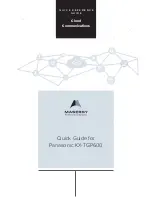
Copyright 2010-2017 Obihai Technology, Inc.
98
line, except that that when the (private) call state is idle (i.e. the call appearance is not being used by this phone), the
SCA state is shown. The SCA state (or shared call state) indicates the call state on the sharing phone that is using that
call appearance, and is communicated to this phone by soft-switch via (SIP) notification. The following SCA states are
supported by the OBi1000:
SCA State
Description
Available Operation
Icon
LED Pattern
Seized
A sharing phone has seized
the SCA to make an
outgoing call
Blinking in red (30 ms
on/30 ms off)
Trying
A sharing phone is trying
an outgoing call
Steady red
Proceeding
A sharing phone is making
an outgoing call and the
called party is ringing
Steady red
Connected
A sharing phone is on a
connected call with that
SCA
Barge In to monitor the
conversation only or to fully
participate in the
conversation
Steady red
Held
A sharing phone is on a call
with that SCA and has
placed the call on hold
Resume and take over the
call
Slow blinking in red
Private Held
A sharing phone is on a call
with that SCA and has
placed the call on private
hold
Slow blinking in red
(100 ms on/100 ms off)
Call Parked
A call is parked against the
extension
Pickup the parked call
Blinking in red (50 ms
on/50 ms off)
Idle
None of the sharing
phones is using the SCA
Seize the SCA to make an
outgoing call
Off
Error
Protocol or network error
Steady amber
SCA implementations are based on subscribe/notify framework. With the call-info method, the subscription expires
value to the call-info and line-seize events are set respectively in
X_CallInfoSubscribesExpires
and
X_LineSeizeSubscribeExpires
(under
ITSP Profile X
–
SIP
). With the dialog;ma and dialog;sla methods, the
subscription expires value to the respective event is controlled by the
X_DialogSubscribesExpires
parameter.
Line Seize
With any Shared line design, each sharing phone should perform a proper line-seize before attempting to make a call
on a SCA. This is make sure the system will work correctly when multiple phones are trying to make calls at the same
time.
With the call-info method, a phone seizes a SCA by subscribing to the line-seize event package for that SCA, with a short
expires value. If successful, the phone will receive a 200 class response for the subscribe method, and also a NOTIFY to
indicate that the subscription is active and what the actual expires value of the subscription allowed by the server.
With the
dialog;sla
or the
dialog;ma
method, a phone seizes a SCA by sending a NOTIFY to the state-agent with the
state of the requested SCA set to “trying”. If successful, the phone will receive a 200 class response for the NOTIFY
request. Typically the state-agent will shorten the subscription interval with the phone who is owning the SCA in order
to detect quickly if the phone has crashed or encountered network issues, etc.
What Happens When a Call Appearance Key is Pressed
















































